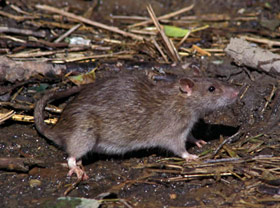Norway Rat (Brown Rat, Sewer Rat) Rattus norvegicus, Black Rat (Roof Rat, Ship Rat) Rattus rattus

Norway rat. Photo from Maine.gov Got Pests?: Rats.
IPM Steps to Reduce Norway Rats and Black Rats
1. Sample for Pest
Confirm the presence of these pests.
Where to find it while inspecting: Inspect along walls and corners for signs of rodent activity. Rats tend to run along walls and use the same routes each time. Crawl spaces of all sorts, and suspended ceilings are common sites of habitation. All rodent pests will leave droppings, urine stains, as well as “smudges” (grease marks) where their oily fur consistently comes in contact with walls and woodwork. Look for gnaw marks. DROPPINGS: mouse droppings are small 1/8" to 1/4" long are have pointed ends. Rat droppings are 1/2" to 3/4" long with blunt ends. Activity will be much more pronounced at night and you will be able to hear activity. Rats prefer nest sites in burrows under ground or under rubbish or debris, in basements.
2. Proper ID
Before you act, determine what species of rodent, specifically rat, is in your building.
Size and Particulars: Norway: 7–9.5" (18–25 cm) plus 6–8" tail. Coarse brown fur. Small eyes and ears, large feet. Compared to mice, small rats have oversized feet and coarse tails (mice have large ears, small feet and smooth tails). Black: 6–8" plus 7–10" tail. Fine brown fur, scaly tail, larger ears and eyes than Norway rat.
3. Learn the Pest Biology
Knowing the life cycle and habitat needs helps you fight these pests.
Life Cycle: Both rats begin to mate at 3–5 months. “Pups” are born after 21–25 days and are weaned at 3–4 weeks. A female can have 3–6 litters a year with 7–8 or more young. Adults average a 1 year lifetime.
Preferred Food Sources: Both rats will eat just about anything and prefer the easy source and will return often. They will always choose a food source in a protected area over one in an open area. Roof rats tend to forage in groups, while the Norway forages alone.
Preferred Habitat: Rats depend on hearing, smell, touch and taste because they have poor eyesight. Yet they travel fast along paths they are familiar with and are strong climbers. Any undisturbed, cluttered area will work. They feed and forage at night and like to live within 25 to 100 feet of what they consider a food source. They will gnaw through almost anything to obtain food and water.
4. Determine Threshold
Your threshold for rat infestation is likely very low. You need to act.
Threshold: While you may only see one rat, they are commensal animals and are known to gather food and return it to the nest site. Occasionally a single “dispersing rat” (frequently a male) will colonize a new location. Rats can carry disease through their feces, fleas, and bites.
5. Choose Tactics
IPM for indoor pests is always a combination of exclusion and sanitation: Try to keep them out. Don’t provide water, food and shelter if they enter your building.
Best Management Practices: Reducing habitat through sanitation and excluding access is the number one way to reduce rat infestation. Remove any debris that serves as cover for nesting sites. Block entrance with coarse screens and caulk in any place that has allowed access. Locate any inadvertent water source and repair it. Keep all food in sealed containers.
Treatment Methods: Due to the tenacity of rats to find food, constant vigilance must be maintained to keep areas free of debris and food scraps. The use of snap traps and bait may be necessary. Poisons are a dangerous solution and not recommended. IPM does work to end rat problems, without the use of poisons.
6. Evaluate
Was the tactic successful? Record the date pests were first noted, and the tactic you used, and its success. Use one of our RECORD KEEPING tools
For More Information:
Evict and Exile Mice from Your Home
Schools Integrated Pest Management for Rats and Mice
Remember:
When a pesticide application is necessary, all necessary and required precautions are taken to minimize risk to people and the environment and to minimize risk of pesticide resistance or pest resurgence. Pesticide use in your school may be prohibited or regulated by local policies or state and federal regulations. Risk reduction methods can include, but are not limited to, spot-treatment, the use of gel or paste bait formulations placed in inaccessible locations, injection into a crack or crevice, and other methods that reduce potential exposure.